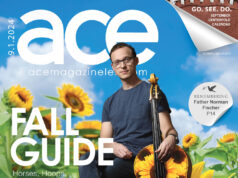This article also appears on page 12 of the January 24, 2013 print edition of Ace.
Latitude Artist Community
the day to day use of performance art and ritual
Compiled by Bruce Burris
with Chase Martin, Meaghan Carpenter, Erin Fizgerald, Teresa Tomb, Caitlin Serey
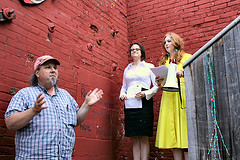
Recently much emphasis has been placed on performance art in this region. Ambitious efforts such as 2011’s Lex LAK Lou an international performance art festival which was held in Lexington and Louisville and sponsored by a number of organizations including UK and the Kentucky Foundation for Women is one example, another was its follow up, last autumn’s Approach, heldat LAL, it was curated by Rae Goodwin and described as “the Lexington Art League’s first-ever exhibition of contemporary performance art exploring situations of separateness and/or the search for harmony…”
Of course performance art is not new to Lexington; practitioners such as Louis Bickett, among others have been creating for years. The addition of local contemporary programs such as LOT and Institute 193 have certainly added much to the region and independent curators such Kurt Gohde and Kremena Todorova have contributed much to the mix, including their most recent effort – a complex community ritual called “The Lexington Tattoo Project.”
For many years Latitude has been creating performances — these have been wonderful and thought-provoking and most importantly performance has allowed us to explore ideas and issues in ways we might never have been able to. A year ago we christened our new space on Manchester Street with a workshop and performance by Lauren Argo of Louisville. Lauren will be back with us again conducting free community performance workshops during our annual open house, this year on Thursday March 28.
I thought it might be fun to contact a few of the artists who have worked with us over the years to ask what their experience had been like. I was hoping for a few sentences, maybe a paragraph or two from each, and instead received much more. I didn’t feel I could edit them — so they are included in full here (with a shorter version in print).
Chase Martin,
Director, Institute 193
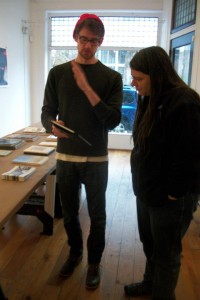 Bruce Burris founded the performance art program ELandF Projects in 2005. During that time, Bruce also worked to establish performance art as a day-to-day program component at Latitude Artist Community, an organization he co-founded in 2001 that provides studio and career supports for artists who are considered by some to have disabilities.
Bruce Burris founded the performance art program ELandF Projects in 2005. During that time, Bruce also worked to establish performance art as a day-to-day program component at Latitude Artist Community, an organization he co-founded in 2001 that provides studio and career supports for artists who are considered by some to have disabilities.
Performances created by both organizations follow common formats. ELandF pieces often appropriate public space and highlight issues of social justice, while Latitude pieces usually address social concerns that are more specific to the interests of the disabled community.
A piece titled “Lives Shaped By Boxes” calls for a hired performer to repetitively assemble and disassemble cardboard boxes. This ritual was designed to explore aspects of work that can be isolating and monotonous, especially in the context of jobs that employment specialists and social workers hold in high regard for individuals with intellectual disabilities. During a performance at Latitude, a performer folded boxes for a period of nearly eight hours, observed by the people who most often perform this sort of job.
When Burris designs a performance piece, he leaves gaps that allow individual performers (and the audience) to insert their own interpretations and draw from their own experiences as they carry out the action of the work. During “Lives Shapes By Boxes,” spontaneous interactions between the performer and the observers allowed the piece to become a truly collaborative effort, and expanded on what Burris believes is a very important conversation.
Over the years, Latitude has quietly become a venue for groundbreaking and relevant performance art. Many of these pieces are seamlessly integrated into the routine activity of the place, which allows them to become useful tools for building community.
Teresa Tomb
Director, Mecca
“Re:Arrangements”
In 1999, Mecca began a performance arts series titled, Re:Arrangments. It was a collaborative idea of Rhea Lehman, Laverne Zabielski and Teresa Tomb. The series requested works from the minds and spirits of local and national artists that would be performed post Galley Hops at Mecca. These pieces ranged in scope from poetry readings, small plays, music and multimedia installations. Often times these installations were collaborations established through invitations to artists of different disciplines to collectively complete a piece of a particular theme or of their own design. Latitude was a frequent contributor to this series and what follows was the result of one of these invitations to contribute.
I am handed a short stack of snapshots from Bruce.
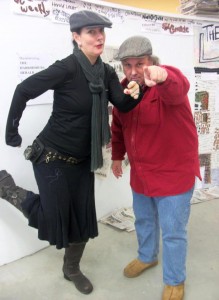 “This is one of our artists, Jesse,” he says. Jesse is an older gentleman and he is blind and deaf. At the time he was living somewhere out in the country. The snapshots contained images of the environment Jesse had created for himself. Lush Kentucky wilderness turned performance art. There is rope and string tied from tree to tree. Aluminum pie pans, fortune cookies, and miscellaneous items tied to the branches dangle from the trees. A shelter that looks like an old fashioned boy scout’s pup tent also hangs from a tree and is made from Kroger bags that have been meticulously sewn together.
“This is one of our artists, Jesse,” he says. Jesse is an older gentleman and he is blind and deaf. At the time he was living somewhere out in the country. The snapshots contained images of the environment Jesse had created for himself. Lush Kentucky wilderness turned performance art. There is rope and string tied from tree to tree. Aluminum pie pans, fortune cookies, and miscellaneous items tied to the branches dangle from the trees. A shelter that looks like an old fashioned boy scout’s pup tent also hangs from a tree and is made from Kroger bags that have been meticulously sewn together.
“Can you do something with this?” asks Bruce. “The idea would be to honor this person’s work.”
This is the motive behind all of Latitude’s art and advocacy. To honor the person, the human whose life experience created this art.
“Sure,” I say. “Do you want me to dance or what direction do you want this to head in?”
Bruce: “I leave that up to you, whatever you do will be fine.”
To honor an artist whose work is so visually profound. Glancing through snapshots of a man, blind and deaf, working, sewing plastic bags together, bags that will provide shelter, sculpture in a green world of lush foliage. Aluminum pie pans dangling from branches sure to produce sound in the rain, wind, alongside birds and insects.
We bring this world into the studio, Mecca. This world that is already performance, this world that is ritual. Not content to commit the audience to the role of voyeur, the audience is drawn into this performance ritual. Randomly the audience is disbursed throughout the studio, standing on spots, facing all directions, looking at each other. There is music provided by Larry, playing his fiddle to which a dancer, myself begins to dance through the room and the audience. Arms are manipulated and sculpted, placed overhead, sticking out to sides like branches. Into the hands of these arms is placed rope. The rope is strung from hand to hand, arm to arm, person to person throughout the space. We are all connected just as the trees in that lush kentucky wilderness where Jesse lives. Larry plays his fiddle, the music of birds, insects. Fortune cookies and pie plates are tied to the ropes by the dancer who continues to move amongst the audience trees. The skirt of her costume is made of Kroger bags that she has sewn together. The music continues. The dancer dances. The audience as trees bear witness to the environment, the art, the visual and sound display that is the world of Jesse, an artist who is blind and deaf.
As the dancer reaches the center of the labyrinth of rope held in place by audience trees, she removes her skirt and hangs it from the ropes, then ducks under the shelter it now provides. The fiddle finishes and all is silent. From the audience Jesse, the artist, stands, reaches up to find the rope. He follows the rope to the center where the skirt made from plastic bags is acting as shelter, as sculpture. Jesse touches the sculpture and then pats his chest at his heart.
“This is me.”
Caitlin Serey
artist, Lives Shaped By Boxes
Participating in “Lives Shaped by Boxes” was a unique experience. It was essentially a symbolic representation of what some of those considered to have disabilities do within the workforce. This type of work is often very repetitive and laborious, performing the same task over and over. Therefore, I folded boxes repeatedly for several hours. For the first few hours it became almost therapeutic, thoughtlessly folding and re-folding without any real awareness of time. However, as the hours rolled on, and as my fingers started getting slightly sore, I caught myself watching the clock more frequently. Overall, it truly was an exciting, new experience, yet it is not exactly something you would enjoy doing every day inside of a warehouse.
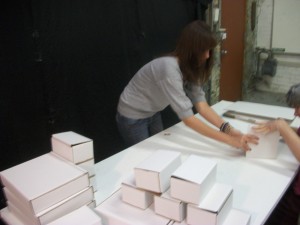 I believe this piece had many very beneficial outcomes. As I folded, a few people spoke, and some even ventured to my table to fold along. It ultimately became a beautiful way to artistically collaborate and provide awareness on an important issue. I believe this type of collaborative performance art is a wonderful addition to Latitude, as it offers the audience and those working with Latitude to create a meaningful and creative experience together.
I believe this piece had many very beneficial outcomes. As I folded, a few people spoke, and some even ventured to my table to fold along. It ultimately became a beautiful way to artistically collaborate and provide awareness on an important issue. I believe this type of collaborative performance art is a wonderful addition to Latitude, as it offers the audience and those working with Latitude to create a meaningful and creative experience together.
Meaghan Carpenter
artist
Trust(ing)
While showing in the Approach performance exhibition at the Lexington Art League, I was invited by Bruce Burris to perform an abbreviated version of my performance piece TRUST at Latitude Artist Community. TRUST (2008-ongoing) is a mobile nail salon, housed within Army parachute where I exchange free manicures for conversation. The space is semi-private which allows other visitors to peer in and eavesdrop and incite curiosity.
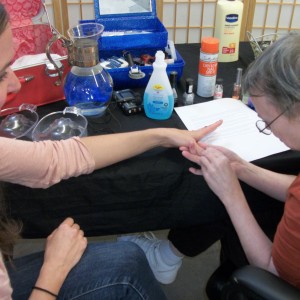 Primarily I am interested in the notion of what it means to trust by performing a task on someone where they, by virtue of the commodity instantly trust you. As well as conversing with a complete stranger and creating a comforting atmosphere so they feel at ease to open up and share their thoughts with you.
Primarily I am interested in the notion of what it means to trust by performing a task on someone where they, by virtue of the commodity instantly trust you. As well as conversing with a complete stranger and creating a comforting atmosphere so they feel at ease to open up and share their thoughts with you.
Usually, I am a bit anxious before I perform this piece. I have expectations from my potential participants and they of me. When Bruce asked me to come to the Latitude Artists Community and perform a collaborative version of my piece I was flattered and very nervous. Never before had I worked with disabled adults and was worried if I could create an atmosphere of trust without my usual space. And would they trust me? A complete stranger entering their studio? Upon arriving at Latitude Bruce’s kind and warm presence put me at ease. He introduced me to the artists; who were all working very diligently and showed me the space. I felt no longer nervous and no boundaries between myself and the fellow artists.
Once we made the rounds he showed me a table where they had gathered manicuring supplies for the collaboration. Everyone stopped working and made a semi-circle around the table.
The Latitude artist who worked with me sat across from me while I talked her though the steps of giving a manicure and the importance of making someone feel comfortable. I first gave her a manicure and asked her about her art, how she liked coming to Latitude and her family, She was shy at first but opened up. After I was done I asked her if she would give me one.
“Sure!” she replied enthusiastically.
I encouraged her to ask me questions.
“Do you have a boyfriend?” she asked sweetly. “I have a husband, we just celebrated our one-year anniversary,”I replied.
“Congratulations! Do you have kids?” She carefully painted my nails red while the others looked on. When we were all finished we traded art. I gave her a Trust towel and she gave me an owl drawing.
My overall experience at Latitude was incredible, inspiring and full of respect and trust. Having a performance art component at a non-profit like Latitude is essential. It breaks down pre-conceived ideas of disabilities
and capabilities and shows everyone that art is beyond physical representation.
Erin Fitzgerald
Artist
4400 Apologies
Last summer I was contacted by Bruce Burris from Latitude about 4400 Apologies – a project paying respect to an estimated 4400 former residents of Eastern State Hospital who died while living at the facility over the 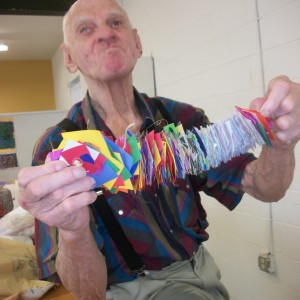 years. I learned about some of the ways in which the remains of the deceased were handled in the process of numerous relocations, finally ending up in a fenced-off area behind the current grounds. The first step of the project involved collaboration with people in the community to create 4400 cards, strung together in the fashion of beads or flowers (as one might find with a rosary or garland), each representing one of the people now believed to be buried in this site, which some refer to as a mass grave. Each card was marked with a thumb print from people who worked on the project, serving as a reminder of the human lives that were lost (and at times forgotten) between death and the final resting place.
years. I learned about some of the ways in which the remains of the deceased were handled in the process of numerous relocations, finally ending up in a fenced-off area behind the current grounds. The first step of the project involved collaboration with people in the community to create 4400 cards, strung together in the fashion of beads or flowers (as one might find with a rosary or garland), each representing one of the people now believed to be buried in this site, which some refer to as a mass grave. Each card was marked with a thumb print from people who worked on the project, serving as a reminder of the human lives that were lost (and at times forgotten) between death and the final resting place.
Once the rosary piece was ready, a date was set to pay respect to the people it represented, by way of individual apologies. My role was to apologize, in the process of counting and handling each card, at the burial site – a sort of ritualistic mediation wherein people in the community were invited to come and pay their respects as well during this time. Following this ritual, the plan was to take the garland to a more public location and repeat the meditation. I would spend 1 ½ hours at each location, adequate time to count and apologize to all the cards both times.
I was told I could handle the ritual itself however I chose – walking around, talking, not talking – whatever seemed most appropriate at the time. Once we were at the cemetery, I just sat down and started sorting through the cards. The reality of the 4400 people represented in this small space was overwhelming as it was, so I felt no need to do anything more then sit and concentrate on the task at hand. I flipped through the cards one by one, running my thumb quickly over each thumb print as I said a silent apology to the person it represented. As it turned out, even as quickly as I was counting and flipping through the cards, I was only able to do half of the apologies while at the cemetery. This was a chilling reminder and visualization of the sheer number of people we were talking about, and really added to the emotion I experienced during the process. It was truly humbling. I decided not to rush things, so finished half of the apologies at the cemetery, then left to complete the rest at the public location outside the downtown library.
The experience at the library was very different. At the cemetery there had been a lot of people who came specifically because of the project, as well as several people from local media. Attendees were interested and reverent, in a purposeful way. Outside the library, on the other hand, it was not clear if anyone there knew who I was or what I was doing. Many of the people hanging out in that location seemed to know each other, and none of them knew me; yet no one questioned my actions or made me feel out of place or intrusive. Other than a few respectful questions near the end of my time there, everyone just left me to my business. It was a different kind of reverence – the kind where it did not matter who I was or why I was there. I was welcomed, right along with my strange ritual, as simply one more person who had a right to be in a public place without being questioned. This, too, was humbling, as I thought about 4400 people from years past who would never have enjoyed such freedom and respect in a public place.
The experience as a whole was thought-provoking and emotional. Even though I knew the story and the plan, nothing could have prepared me for the powerful effect of the apology process. I have participated in a few other events and collaborations with Latitude, and each time I have left with a feeling that was hard to put into words at the time. Looking back, though, I can describe it with one simple word. Community. I have rarely seen a group of people so devoted to true community involvement, engagement, and exploration as the people I have met through Latitude. It is refreshing and encouraging, and it is up to us all, to support the change we would like to see in our community.
Latitude Artist Community Open House with free workshops facilitated by performance artist Lauren Argo will be March 28 9am – 3pm.





